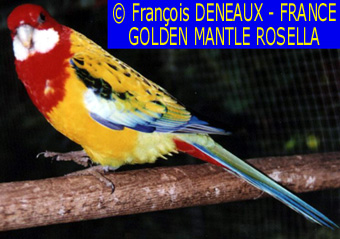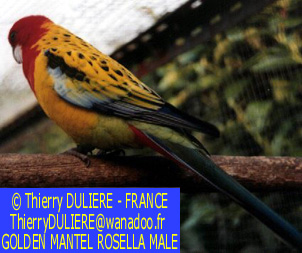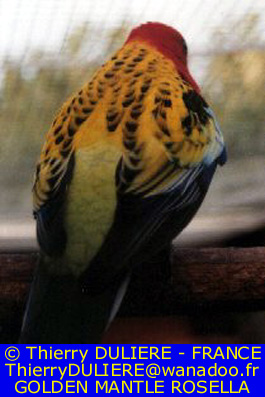| I dedicate this web site to the late Dominique LESTRINGANT, probably the best French breeder of Golden Mantle Rosella and the first which try to etablish the GOLDEN mutation. |
Welcome on ROSELLA, the webpage dedicated to
EASTERN ROSELLA & GOLDEN MANTLE ROSELLA
Platycercus eximius eximius & Platycercus eximius cecilae
The EASTERN ROSELLA, Platycercus eximius eximius, is one of the most popular Australian parrakeets. It is a member of the Platycercus genus which also include :
Platycercus caledonicus - GREEN ROSELLA
Platycercus elegans - CRIMSON ROSELLA or PENNANT ROSELLA
Platycercus adelaïdae - ADELAÏDE ROSELLA
Platycercus flaveolus - YELLOW ROSELLA
Platycercus adscitus - PALE-HEAD ROSELLA
Platycercus venustus - NORTHERN ROSELLA or BROWN ROSELLA
Platycercus icterotis - WESTERN ROSELLA.
Three subspecies are reconized, Platycercus eximius eximius, EASTERN ROSELLA, the nominate form, 30 cm, which occurs in central and southern New Xouth of Wales across Victoria to southeast South Australia, Platycercus eximius cecilae, the larger GOLDEN MANTLE ROSELLA, 33 cm, living in northwest New South of Wales and southeast Queensland, and Platycercus eximius diemensis, the TASMANIAN ROSELLA, 30 cm, only found in Tasmania island.
In European aviculture, the Tasmanian Rosella is unknown but the two other subspecies are hybridized and almost no pure birds of each subspecy is available. In fact, we are breeding three kind of birds, the GREEN BACK, a selection of esatern rosella in which the underblackpatches is green, the yellow back in which it is yellow and the GOLDEN MANTLE which have a nice yellow back with SMALLER black back patches.




These captive bred varieties are selected birds and if the GOLDEN MANTLE is very close to the Platyercus eximius cecilae subspecy, the black back patches are smaller than in wild birds. Another characteristic of captive bred birds is the perfect limit between the red breast and the yellow belly.
To breed the Eastern Rosella, and the Golden Mantle also, you will house them in an aviary, only this agressive pair in one aviary, and provide them a wood nest block (22 cm x 22 cm x 40 cm hight). You'll provide them several seeds in which sunflower seeds will be under 10 % during winter and under 5 % during spring, summer and autumn. I provide them diverse seeds including 65 % flat millet (canary seed). During youngs feeding, I add a mixture with 50 % sprouted seeds added to 50 % of dry egg food. You need to understand that in wildlife, they will never find dry seeds but only fresh seeds.
In aviculture, some mutations occurs and the breeder's work is to etablish them in strong strains.
Many thanks to my friend François DENEAUX which give me some pics of the late Dominique LESTRINGANT Golden Mantle Rosella (first and third photo).